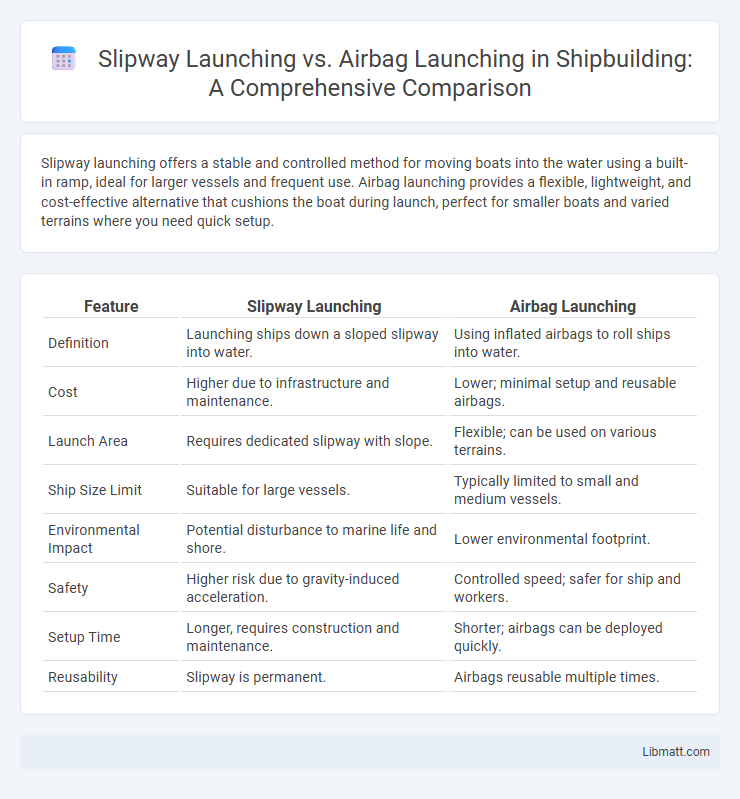Slipway launching offers a stable and controlled method for moving boats into the water using a built-in ramp, ideal for larger vessels and frequent use. Airbag launching provides a flexible, lightweight, and cost-effective alternative that cushions the boat during launch, perfect for smaller boats and varied terrains where you need quick setup.
Table of Comparison
| Feature | Slipway Launching | Airbag Launching |
|---|---|---|
| Definition | Launching ships down a sloped slipway into water. | Using inflated airbags to roll ships into water. |
| Cost | Higher due to infrastructure and maintenance. | Lower; minimal setup and reusable airbags. |
| Launch Area | Requires dedicated slipway with slope. | Flexible; can be used on various terrains. |
| Ship Size Limit | Suitable for large vessels. | Typically limited to small and medium vessels. |
| Environmental Impact | Potential disturbance to marine life and shore. | Lower environmental footprint. |
| Safety | Higher risk due to gravity-induced acceleration. | Controlled speed; safer for ship and workers. |
| Setup Time | Longer, requires construction and maintenance. | Shorter; airbags can be deployed quickly. |
| Reusability | Slipway is permanent. | Airbags reusable multiple times. |
Introduction to Ship Launching Methods
Slipway launching involves sliding the vessel down a greased ramp into the water, providing a traditional and controlled method ideal for various ship sizes. Airbag launching uses inflated rubber airbags beneath the hull to float and roll the ship into the water, offering enhanced safety and adaptability for challenging terrains. Your choice between these methods depends on factors like ship size, launching environment, and cost-efficiency requirements.
Overview of Slipway Launching
Slipway launching involves the use of a sloped structure that extends from the shore into the water, enabling vessels to be gradually lowered or raised during launching or recovery. This method provides precise control and is ideal for larger boats or ships, as it supports heavy loads with minimal risk of damage. Slipway launching minimizes environmental impact by reducing sediment disturbance compared to other methods like airbag launching.
Overview of Airbag Launching
Airbag launching offers a versatile and cost-effective alternative to traditional slipway launching for boats, utilizing inflatable airbags to support and roll vessels into the water safely. This method reduces the need for expensive infrastructure and allows for launching in varied coastal environments, making it ideal for smaller marinas and private boat owners. Your choice of airbag launching can streamline operations while minimizing environmental impact and maintenance costs.
Comparison of Cost Efficiency
Slipway launching typically requires higher initial capital investment including construction and maintenance of permanent infrastructure, making it more cost-effective for frequent, large-scale launches. Airbag launching involves lower upfront costs and enhanced flexibility, ideal for smaller vessels or shipyards with limited space, reducing overall expenditure on structural setups. Operational costs favor airbags due to their portability and reduced labor requirements, suitable for companies prioritizing budget-friendly, scalable launching solutions.
Safety Considerations and Risks
Slipway launching involves a controlled descent of vessels into water using rails or greased surfaces, posing risks of mechanical failure and injury due to sudden movements or equipment malfunction. Airbag launching uses inflatable airbags to roll the vessel into the water, reducing direct contact hazards but introducing risks such as airbag rupture or improper positioning. Both methods demand rigorous safety protocols, including regular equipment inspection and trained personnel, to mitigate potential accidents during vessel launch operations.
Environmental Impact Assessment
Slipway launching produces localized soil erosion and potential disruption to marine ecosystems due to heavy machinery use and concrete structures, necessitating thorough Environmental Impact Assessments (EIA) to mitigate sedimentation and habitat loss. Airbag launching minimizes seabed disturbance and reduces carbon emissions by eliminating the need for heavy equipment, leading to a lower overall environmental footprint assessed during the EIA process. Your choice between slipway and airbag launching should consider specific EIA findings to ensure sustainable vessel launching practices and compliance with environmental regulations.
Suitability for Different Vessel Types
Slipway launching is ideal for larger, heavier vessels such as commercial fishing boats and passenger ferries that require strong structural support during launch. Airbag launching suits smaller to medium-sized vessels like yachts and fishing boats, providing a flexible and cost-effective option for uneven or sloped slipways. Your choice depends on vessel size, weight, and hull design to ensure safety and avoid damage during launch.
Space and Infrastructure Requirements
Slipway launching necessitates substantial coastal infrastructure, including reinforced ramps and winching systems, limiting its use to locations with adequate shoreline and construction capabilities. Airbag launching requires significantly less fixed infrastructure, relying on portable airbags and rolling surfaces, making it adaptable to limited space and varied terrains. The compact setup of airbags suits smaller boatyards or areas where traditional slipways are impractical due to spatial constraints.
Advantages of Slipway Launching
Slipway launching offers precise control over vessel entry into the water, minimizing the risk of damage during launch and recovery. The reinforced structure supports heavier loads, making it suitable for larger and commercial vessels. Your investment in a slipway ensures operational efficiency and enhanced safety compared to airbag launching methods.
Advantages of Airbag Launching
Airbag launching offers significant advantages over slipway launching, including enhanced safety by reducing impact forces on the hull and minimizing environmental damage caused by heavy equipment. This method allows for easier and more flexible vessel placement in challenging or shallow waters, improving accessibility for various types of boats. Your boat benefits from faster turnaround times and lower operational costs due to the simplified logistics and reduced infrastructure requirements associated with airbag launching.
Slipway launching vs airbag launching Infographic

 libmatt.com
libmatt.com